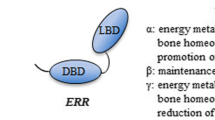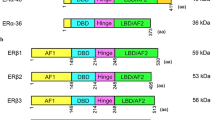Abstract.
This review aims to evaluate the impact that human estrogen receptor-α (ER-α) synthesis, modification and degradation has on estrogen-dependant physiological and pathological processes within the body. Estrogen signaling is transduced through estrogen receptors, which act as ligand-inducible transcription factors. The significance of different isoforms of ER-α that lack structural features of full-length ER-α are discussed. The influence of differential promoter usage on the amount and isoform of ER-α within individual cell types is also reviewed. Moreover, the potential role of phosphorylation, ubiquitination and acetylation in the function and dynamic turnover of ER-α is presented.
Similar content being viewed by others
Author information
Authors and Affiliations
Corresponding author
Additional information
Received 12 February 2002; accepted 14 March 2002
Rights and permissions
About this article
Cite this article
Reid, G., Denger, S., Kos, M. et al. Human estrogen receptor-α: regulation by synthesis, modification and degradation. CMLS, Cell. Mol. Life Sci. 59, 821–831 (2002). https://doi.org/10.1007/s00018-002-8470-2
Published:
Issue Date:
DOI: https://doi.org/10.1007/s00018-002-8470-2




